As I push deeper into the mysteries of painting bamboo I discover even more painting subtleties that can contribute to the overall effect of any CBP composition. The latest insights pertain to a style of rendering bamboo that some call “outline”, others “elaborate” or “detail” style. Yet another refers to it as “contour” style. Such paintings are sometimes included in the back pages of a book dedicated to bamboo, but very little instruction is given.
Basically the method entails “drawing/sketching” or “outlining” bamboo leaves, stems and stalks with a fine brush and then coloring in the shapes. When the coloring is done in layers of shades with drying in between, it is an approach I’ve previously learned to call “gongbi”.
Resources:
I have filed away numerous examples of bamboo painted in the outline manner, but so far have found only one manual that offers some direction: Johnson Su-sing Chow’s vol. 2 Book of Bamboo. He tells us there are TWO types of “outline” or “white sketch method”—Tan Kou or single outline and Shuan Kou or double outline.

I bought the book on the left for its crane compositions but soon discovered the artist Liu Shujun used OUTLINE style bamboo (similar to the treatment of narcissus grass on the cover) in several of his paintings. The book on the right (by Johnson Su-Sing Chow) is the only one I’ve found that addresses HOW to paint bamboo in outline style.
Chow’s accompanying illustrations and notes all pertain to what he refers to as Shuan Kou, or simply “white sketch” method. Alas, he does not mention the Tan Kou method again, or explain the single vs. double line distinction. As my online researching was limited to English-only sources, I could find nothing more on the subject.
In workshop notes from local artist Nenagh Molson, the ‘single outline’ method is illustrated as outlining the outer edge of leaves; the ‘double outline’ method is shown with a second pairing of lines to suggest the central vein of each leaf , emerging from the base of a leaf.
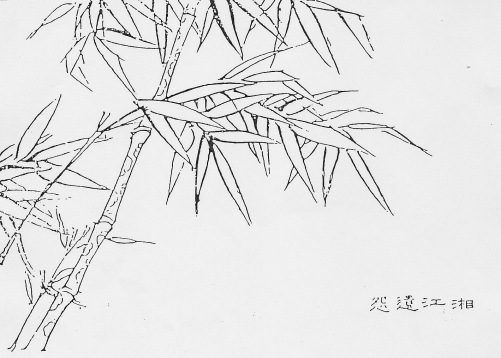
This is bamboo in ‘single outline’ or Tan Kou ready to be colorized. Note the few leaves that end slightly twisted; one has to plan to color those differently–usually darker–to indicate the underside of leaves.
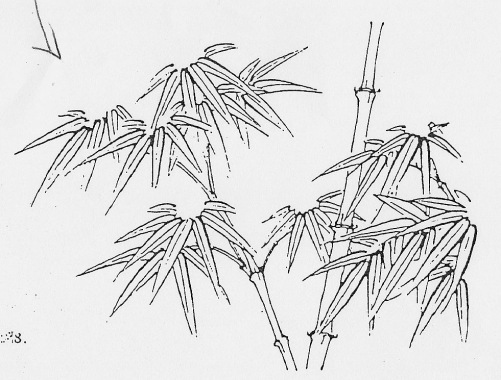
This is an example of bamboo sketched in the “double line” sketch method or Shan Kou. There seems to be some leeway in rendering the second (central vein) line: here the line is a single long stroke, some of my examples have a short little vee stroke, others a two-stroke shape that mimics the outer edge lines.
Earlier this year I purchased a book featuring crane paintings by artist Liu Shujun, and soon realized not only did he render the birds in pleasing postures and interactions, BUT he also used unusual treatments for many of the setting elements, his pine and bamboo in particular. On second look, I determined his bamboo in several compositions was done in OUTLINE style! The leaves in two comps appear done with mineral paints (one is green, one is blue) and that would imply they were painted green/blue first, as mineral paints must be applied OVER a color. A third comp shows bamboo in a soft blend of greens and indigo.
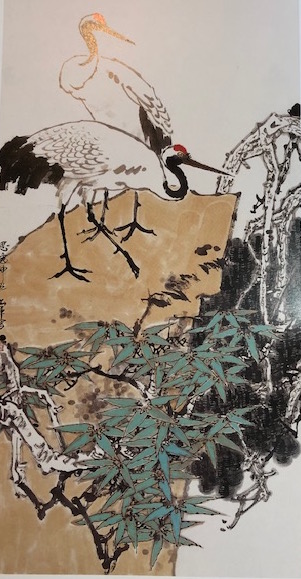
Liu Shujun’s bamboo above features a short vee stroke in the centre of each leaf for the central vein.
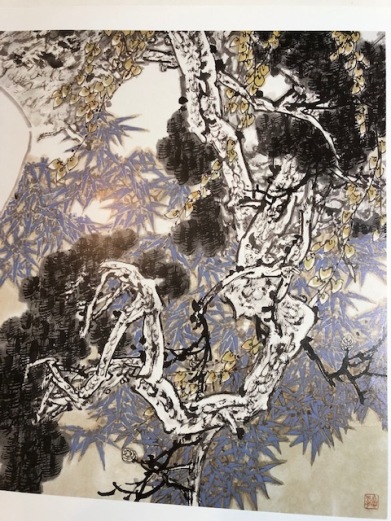
Here his double outline bamboo leaves are colored blue, with the central vee not quite as dominating.
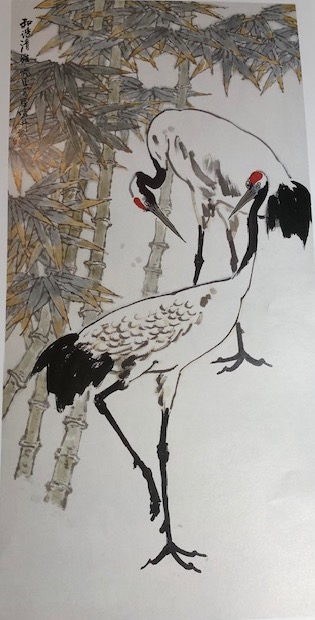
The ‘second’ strokes are more prominent in his multi-colored Shan Kou bamboo.
I did manage to find an image of an old bamboo painting online, attributed to a Li Kan allegedly in the Sheong Gu style. (another spelling for Shan Ku?)
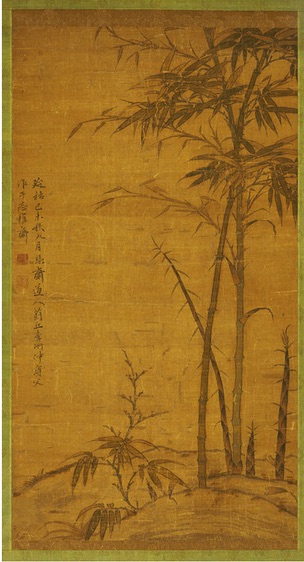
I also found a book of animals by an artist named Xu Gu of the late nineteenth century (Qing dynasty), that featured some loosely painted ‘outline style’ bamboo.
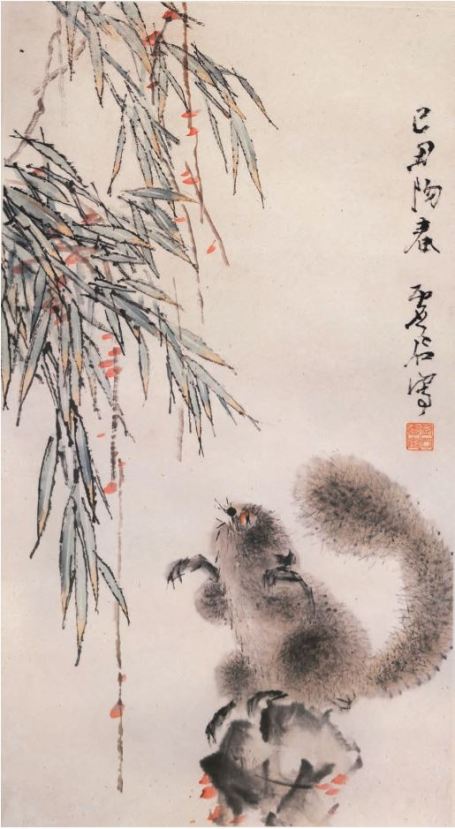
Further research led to a web site for The Mozhai Foundation, a non-profit organization dedicated to furthering appreciation for Chinese art, where Xu Gu’s paintings were discussed. Squirrels were among his favored subjects; the notes accompanying the above painting at the Mozhai Foundation site provided some insight into painting Shuan Kou style bamboo:
“Stalks of bamboo enter the painting from the upper left. In contrast to the “boneless” brush used in Green Bamboo (cat. no. 3), Xugu employs the “ double-outline” method and fills in the forms with color. But unlike a traditional double outline, which relies on long, smooth, flowing lines, the artist employs a thirsty brush with scorched ink in combination with zhan 顫 (quivering), duan 斷 (broken), and nishixing 逆勢行 (reverse-momentum) strokes to outline the bamboo leaves. The resulting linework—rough, broken, and dry— captures the worn appearance of stele engravings and conjures resonance and rhythm that is simultaneously archaic and fresh.”
I then realized I already had some other XuGu paintings in my electronic files, stashed under squirrels:
At first I found the squirrels rather cartoon-ish, but loved the bamboo; in time, the quirkiness of the squirrels grew on me. His use of “contrast” as a design principle (arching tails vs. straight canes, line work for the leaves vs. fluffiness of body fur) and the choice of blue (not green) as a dominant color are obvious deliberate decisions contributing to the overall effect. Outline style bamboo is “growing on me”!
Principles of painting bamboo in White Sketch (ShuanKou/Sheong Gu) or “double outline” method
According to Su-Sing Chow the tan kou and shuan kou are the MOST ancient methods of rendering bamboo. Incised drawings on ancient artifacts of bone, jade, bronze and stone are all predecessors to painting bamboo on silk or paper in this manner.
The lines should be “straight, clear, and accurate and all details must be shown with meticulous care” says Su-Sing Chow. “To learn this more difficult style of painting start by practicing the small branches or a leaf and do them over and over many times. Then try several leaves in a row until you can do them easily.”
Leaf lines must be very fine and not appear like steel threads, according to Chow. You want to render a leaf edge in a ‘thick and thin’ manner (varying the width of the line) and have the ends meet (not overlap/cross and not leave a gap). You want the end points of stems, on the other hand to be OPEN, not meeting or overlapping. (He would obviously be discussing the traditional double line method, not the Xu Gu variations.)
This is a principle that pertains to painting all trees and shrubs as well, but is often neglected by novice painters. To practice outlining leaves and stems so that you can meet your leaf tips, and leave thin stem ends open, all the while maintaining a thin line of ink that shows no hint of hesitancy or re-directing…..I can see why the method is deemed the MOST difficult.
Another tip regarding painting bamboo in this method is to REVERSE the usual order of steps in a composition. Whereas in ‘freestyle’ (moku) one starts with canes, adds nodes then branching and finally leaves, in ‘outline’ style it is recommended you start with the leaf clusters, add the branches, and lastly the canes. Such an approach will allow you to better envision distribution of leaves in front of and behind branches and canes, according to Su-Sing Chow. He also urges practicing such compositions in ink only before attempting to add color.
Another principle I tripped over, and is evident in the bamboo in the crane comps of Liu Shujun, is to paint canes with joints, but not with the darker node lines. Small point, but with CBP, the ‘devil is often in the details’ so I will strive to heed the advice.
My studies of ink only, outline style bamboo:
Initially drawn to Liu Shujun’s crane comps I had played with his ‘double outline bamboo’ style before launching into a more in-depth study of it. Oddly enough I discovered on my own that it was easier to START with the leaves before sketching in the canes! (See principles above.)
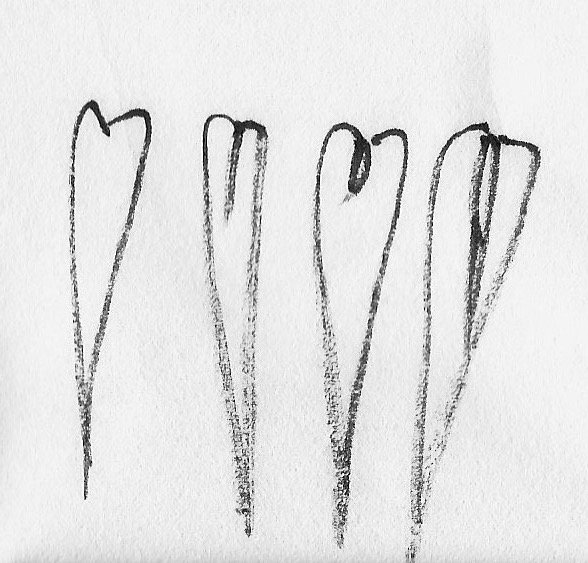
There seem to be some variations to depicting the central vein when painting in the ‘double outline’ manner.
Once I acquired Chow’s directions for rendering the single and double outline methods I produced these:
I found the double outlines easier to execute than the single ones, and that control of coloring the leaves was tricky. (Using a specialty brush designed for depicting thin vine tendrils was also helpful.) Then I tried to emulate Xu Gu more closely:
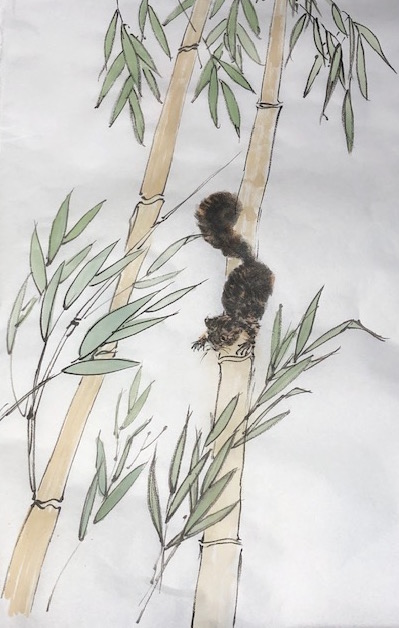
At this point in my studies Delightful Lotus pointed me to some pages in Diana Kan’s The How and Why of Chinese Brush Painting, wherein she addresses a method she called “contour style“. Aha! Yet again instructions were minimal, BUT the artist did add to my understanding of the outline methods for painting bamboo. She provided several excellent examples of single outline leaf clusters AND repeated the direction to render the canes without node demarcations. She also suggested a short VERTICAL LINE above and below a node to further enhance the look of the cane (see below lower right). My Xu Gu study above would benefit from those vertical markings; the canes are rather plain without them.
Traditional ways to color in the outlined bamboo leaves and stalks seem to have emerged (light green undercoat followed by indigo highlighting), as well as some interesting combinations of elements of the “freestyle” and “outline” methods. White leaf veining (in single or multiple lines) over freestyle leaves is one, ink outlining over purple colored stalks is another. Those combinations also seem to be ‘back page’ methods seldom described. And in one inside cover of a book I found this splendid example of outline style bamboo using gold paint:

Always practice bamboo, they say. With SO MANY ways to portray it and variations on the coloring of outline style, I see more studies in the near future.






